|
Czerwonogrod (Czerwonogród)
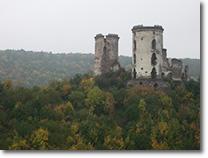 |
|
I had been intending to visit Czerwonogrod
for many years, but something always seemed to keep
me from undertaking the journey – usually
a combination of inclement weather and work. However
in 2007 my interest in Czerwonogrod was piqued again
when I received the following email from reader
Lucy Gertner, who asked me to post her message on
the website in hopes of finding someone with answers
to her query: |
“I am writing to you because I am seeking
information about myself, in particular, about my early
childhood. I was born in Buczacz and during World War
II, was placed in a convent and raised as a Catholic.
The convent was in Czerwonogrod, which I believe is
near Tluste and a priest in Tluste helped arrange for
my placement in the convent. I was there from the ages
of 2 until 5 and have no memory at all of my stay there
or of the years thereafter. My mother survived the war
in hiding and we were reunited at war's end. We spent
1945-49 in a DP (Displaced Persons) camp in Germany
(Foehrenwald), coming to the United States in 1949.
My mother told me that following the liberation, the
convent was burned and the remaining children and nuns
killed by hostile neighbors. I don't know whether this
is what actually happened and wonder whether there are
any surviving inhabitants of the area who recall those
years and could possibly provide me with additional
information about the convent and its occupants. If
you can help me by posting my query on your website
or informing any known persons of my search, I would
greatly appreciate your help. Thank you for doing this
important and humanitarian work and I send my best wishes
to you and your family. Lucy Gertner (formerly Lusia/Luscha
Fenster) New York City”
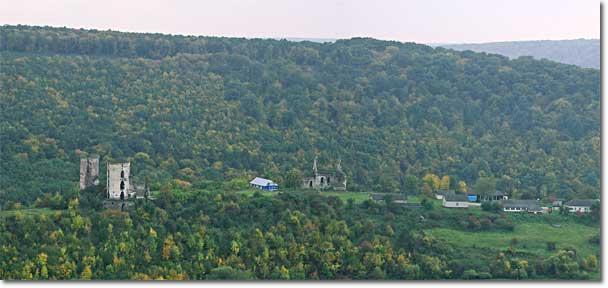
|
An opportunity to visit Czerwonogrod finally
presented itself in October 2007, when I traveled to this
enchanting place – about 11 km southwest of Tovste
– for the very first time.
More importantly, my trip and subsequent research offered
some tangible evidence in support of Lucy’s quest
for knowledge about her childhood. |
|
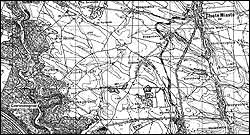
Click to enlarge 1923 Polish era map |
More on this later, but first a bit of background
on Czerwonogrod. |
Background
I'm sure there are more authoritative sources of information
on Czerwonogrod in the literature and even on the web
(in Polish or Ukrainian), but the following details
are sufficient for a Czerwonogrod 'primer'.
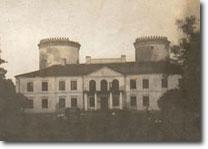 |
|
When people refer to Czerwonogrod,
they are likely thinking about the remains of the
impressive castle that once stood there. It takes
its name, quite literally, from the red stone from
which it was constructed. But in former times (ie
during Polish administration), Czerwonogrod was
surrounded by a small collection of houses, so the
name once referred also to a village, which no longer
exists. Click to view an aerial
photograph of the landscape on an external website. |
|
| The residents would have been peasants who worked the
land and provided produce, such as milk and eggs, to their
feudal landlord. They lived in wonderful surroundings,
blessed by the presence of a splendid waterfall, which
provided the driving force for running the mill that once
stood on the banks of the water course. |
|
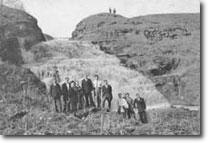 |
According to Pawlyk (pers.comm., 2007), Czerwonogrod
was first mentioned in 1240, but there was already a
wooden castle on the site in the 9th century, during
the period of Kyiv Rus. There is also said to be evidence
of human occupation in the area around 2000 years BC,
in the form of a massive carved stone – of Stonehenge
proportions – that would have been an object of
prayer.
Thus Czerwonogrod has a centuries old existence, one
that was closely linked its relatively close neighbour
Tluste. Indeed, during the 1830s, the major landowner
in Tluste, Fürst (Prince) Poninski was one of the
last in a long succession of residents of the castle
of Czerwonogrod. (At some point, the ownership passed
to Maria Lubomirska who lived in the palace until around
1939 when she was forced to flee.)
The Convent
In 1844, Fürst Poninski’s wife, Helena Gurska,
arranged for the construction of a hospital / convent
nearby. It would serve the whole of Zalishchyky district
for the next 100 years. It was situated on top of a
steep hillside overlooking the castle, just in front
of the modern day village of Nyrkov.
Details of the convent are given in the 7 November
1857 issue of Gazeta Lvovski (no. 45), which can be
found in the Lviv archive or one of that city’s
specialised libraries (Pawlyk, pers. comm.). The three-story
building was constructed of the red stone typical of
the area. With some 30 beds, the convent served to treat
the local populace and give comfort to orphaned children.
In the mid-1800s, it was run by Karolina Pisko (transliterated
spelling) and five nuns.
* * * * *
|
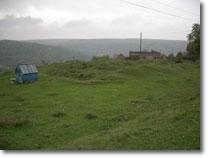 |
|
Fast forward to 2007 and the fascinating
story of Lucy Gertner. I was interested to learn
if anything remained of the convent and to see for
myself exactly where it was located. I soon had
my answer, courtesy of Jaroslav
Pawlyk, who informed me that the building was
destroyed by the Soviets around 1944. He proceeded
to show me where the foundation once stood. This
is all that remains today of the convent overlooking
Czerwonogrod castle. |
Pawlyk knew of the building’s demise because,
through an odd twist of fate, he had a personal involvement
in its demolition. That year, while working as director
of the school in Rozanivka, a village 2 km south of
Tluste, Pawlyk's allegiance to his new Soviet masters
was put to the test. Although it was against his personal
convictions, he was ordered by the head of the Rozanivka’s
collective farm – a man by the name of Levshenko
– to help transport stone from the destroyed convent
to Rozanivka, where it was used to build sheds for cattle.
Had he not obeyed the request, non-compliance would
have been interpreted as a sign of anti-Soviet sentiment.
The story of the convent does not end there, however,
as my own research revealed an even more interesting
history. A number of first-hand accounts confirm the
story of Lucy Gertner – namely, that the convent
once served to shelter not only orphans but also young
Jewish children who were placed there by parents seeking
to hide them from the atrocities of the war.
In the original Polish manuscript of his diary, Baruch
Milch describes the convent run by three Sisters
of Mercy and their Mother Superior. The following passage,
translated into English, appears in The Righteous,
by Martin Gilbert: |
| |
‘These heroic women ran
the religious services of the parish, conducted
the choir, played the organ and managed the kindergarten.
Later in the summer they opened a secret shelter
for foundlings. Among these tiny outcasts were about
six or eight Jewish children left by desperate parents
roaming the fields and forests, or just found abandoned
at the monastery’s threshold.’ On one
occasion the three nuns found in their backyard
a four-year-old boy, speaking only Yiddish. ‘They
gathered him into their midst. As long as the murderers
were unaware of what was going on behind the walls
the self-sacrificing women shared their scanty provisions,
fed their charges, cared for them and took them
to the church.’ |
|
|
But the convent had an even darker story to tell, as
revealed by one of its former residents, Karolina Heuman.
The following information is contained in a major compilation,
by Mark Paul, entitled “Wartime
Rescue of Jews by the Polish Catholic Clergy”.
(Click on the link to download a 1.1 MB pdf file.)
After escaping from the ghetto in Drohobycz, Ms. Heuman
and her younger brother Henryk were placed by their
father in the convent of the Sisters of Charity of St.
Vincent de Paul in Nyrków near Czerwonogród.
[I presume this to be the same convent mentioned above,
since it is unlikely for there to be two such edifices
in close proximity]. Ms. Heuman recalled those turbulent
years in her account published in Sliwowska, The
Last Eyewitnesses, at pages 187–89:
| |
“I remember how we were driven
by night in a horse-drawn wagon to the cloister
and how Father bade us farewell. Pointing to the
sky, he said, “We shall meet there.”
He then paid for our stay with money he kept hidden
in a bottle, and he left. From that moment I never
saw him again.
In the cloister, I used the name Marta Regusz.
I worked in the fields. Whenever Germans showed
up in the cloister, I would die of fright (after
all, my brother was circumcised!). After placing
us in the cloister, Father went into hiding in
Horodenka, where he was shot at the beginning
of 1943. … I don’t know where Mother
perished. … My brother perished during a
raid on the cloister by the followers of Bandera
[Ukrainian nationalist partisans who attacked
Poles]. He was then nine years old. Here is how,
at the time, I described the events of this horrible
day:
“It was the second of February 1945, at
eleven o’clock. … There were three
of us young girls and my beloved brother …
I woke up with a start during the night and heard
terrible shooting around the cloister. …
I got up and walked up to the window. …
All of us girls were already dressed when Sister
Wladyslawa walked in and said we were surrounded
by Bandera’s followers. We were terrified.
“Right away, we went over to the bedrooms
of the Sisters, and there, by the window, we stood
for three hours, watching the terrible tortures
of people who were fleeing in panic from the flames.
The inhuman barbarians ran around furiously with
flares in their hands and set fires to one hut
after another, and whenever they saw someone,
if they could, they grabbed him alive, and if
not, then they would shoot him on the spot. They
captured one family in our village and all that
was later found of the children were fragments
of burned-up bones, and the father’s skin
had been ripped off from his stomach all the way
to his head. We, the girls, stood all the time
by the window, waiting for what would happen next.
We felt that our own lives, too, were hanging
by a thread. … “Soon, our suppositions
came to pass. At three o’clock in the morning,
we heard terrible knocking on the front gate,
which seemed to foretell our approaching end.
Sister Wladyslawa called us into the chapel and
began to pray and prepare us for death. We knelt
in front of the altar for perhaps ten minutes.
… “I had no regrets about dying, because
until then I had not experienced contentment on
earth. … In the last moment, when the glass
of the windows in the lower corridor started falling
onto the floor with a loud crash, Sister Superior
hid us under the altar.” |
It is reported that during the Ukrainian attack on
Czerwonogród some 60 Poles lost their lives,
including the pastor Rev. Szczepan Jurasz and two nuns.
The Jewish children hidden by the nuns survived.
An account given on a Polish website
that describes the history of Czerwonogrod also refers
to a massacre of Poles at the hands of the UPA, which
took place during the night of 2-3 February 1945. Click
on this external link
for a map that shows the castle of Czerwonogrod and
surrounding buildings, including the convent.
This leaves us with strong evidence that the convent
at Czerwonogrod remained intact at least until February
1945, but its days were probably numbered after that.
It is plausible that later in the same year, it was
ordered destroyed by the Soviets as part of a drive
to rid the land of symbols of religious affiliation.
Even more interesting from a personal standpoint is
the direct connection of these passages to Lucy Gertner’s
quest for answers about her past, which was the initial
impetus for my investigation.
The present
And what about Czerwonogrod today? In a sense, this
enchanting place in the middle of a valley surrounded
by dense forest epitomises the best and the worst –
as well as the past and potential – of western
Ukraine.
Sadly, the former castle of Czerwonogrod – its
splendour revealed in photographs from the 1930s –
has deteriorated over the years, almost beyond recognition.
Left to the mercy of the elements, stone thieves, and
young vandals intent on inscribing their names on every
surface they can reach, the once proud castle is probably
reaching the point of no return. There is not much left
apart from the shell of the two graffiti-scarred towers.
Once one or both of these structures start to collapse,
it probably won’t take long for this familiar
landmark to be erased from the skyline.
Czerwonogrod photo gallery (click on each image
to enlarge):
|
Yet, all is not lost. The beautiful landscape around the
castle is still largely intact, partly because of its relative
inaccessibility during inclement whether. (Heavy rain turns
the dirt track leading down the valley into a muddy mess that
is difficult for most vehicles to negotiate, until dried again
by sunshine.)
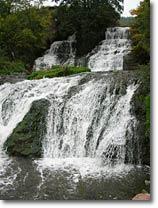 |
|
The waterfall at Czerwonogrod is
a sight to behold at certain times of the year
when it is most vigourous. One could not imagine
a more pleasant spot for a day-long outing for
families, in the tranquil surroundings and fresh
air. During the summer months, a youth hostel
operates on the site (which explains all of the
grafiti).
Alas, too many people with the same idea and
a total lack of respect for nature, can despoil
even the most beautiful of places. Fortunately,
this rubbish
collection point is relatively concentrated,
but discarded plastic can be found scattered around
the site. |
|
|
|
Within walking distance of the castle, one can explore the
remains of what appears to have been quite an impressive church.
And overlooking the valley, with a stone's
throw of the foundation of the convent, stands the outer
shell of a mausoleum constructed for the Poninski clan
in the 1800s.
Click on this link
to an external website that shows how the massive mausoleum
looked in former times. |
|
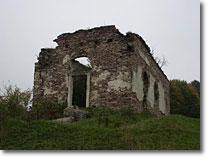 |
Finally, as an added bonus on a day-long outing to Czerwonogrod,
it's worth taking a detour on the way back to Tovste,
to catch a splendid view of the Dniester River as it
meanders across the countryside near Ustechko.
|
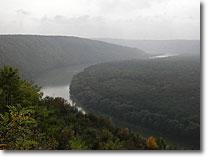 |
|
Follow the main road leading from Nyrkov
to Torske, and turn right on the dirt road just after
crossing the major intersection that lies between these
two villages. |
|
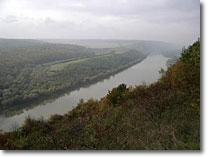 |
A vision of the future
With the castle restored to its former glory and protected
by the status of a national park (with entry regulations,
and perhaps even a modest entrance charge to offset maintenance
costs), Czerwonogrod could one day join the league of other
historical places in western Ukraine that appear on the itinerary
of domestic and foreign tourists. All that is needed is an
infusion of capital and a healthy dose of civic pride among
people who must come to appreciate that the potential for
Ukraine’s future prosperity lies, to some extent, in
its past.
Douglas Hykle
November 2007
* * * * *
| PS: There is not much written about Czerwonogrod
on the web in English; however it does receive mention
on a number of Polish websites, including one that has
several old
and modern photographs that give a good impression
of what Czerwonogrod would have looked like in the 1930s,
as well as today. There is also a website in Ukrainian
that is worth taking a look at: https://www.castles.com.ua/index.php?id=chervon
Location: Approx. 11 km southwest of Tovste
Visiting: It should be possible to find a driver
in Tovste willing to go to Czerwonogrod for a few hours,
provided the road is accessible.  |
|

